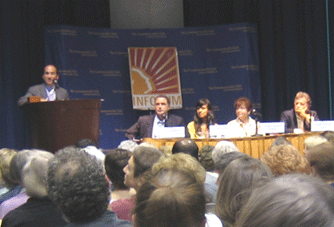Olivet College of Journalism students recently attended a Commonwealth Club lecture entitled "Newspapers are Dead. Now What?" to learn about innovative ways to develop a for-profit news model amid an era of abundant, free digital content.
Before the advent of the internet, the newspaper industry thrived with newspapers being able to generate 80 percent of their revenue from advertisers and 20 percent from circulation and subscribers. But as readers began to access treasure troves of free content online, newspapers have been forced to cut staff in their newsrooms to meet the costs of their operations.
However, the reduction of journalists has lead to a dilemma: how can a newspaper provide high-quality journalism/news and still keep afloat during tough economic times?
At the Commonwealth club event, held minutes away from Olivet University's main campus, invited panelists tackled the problem as OCJ students listened in the audience.
"Newspapers are not dead…but the old model is dead," said featured speaker Phil Bronstein, former executive VP and editor of The San Francisco Chronicle and current editor at large at Hearst Newspapers.
Bronstein explained that in order for newspapers to survive they must invest more in journalists. He recognized that one challenge in the industry is that today's readers receive a lot of news from citizen journalists, bloggers, and social media applications like Twitter. But one suggestion, he offered, was to explore ways where professional journalists can collaborate with amateurs, such as in the Iran election controversy, to serve the public as watchdogs.
Kara Andrade of the Web site Spot.Us spoke about the model of "community-funded reporting" where journalists, including freelance writers, can propose news story ideas and use Spot.Us to raise funds toward the costs of investigative news reporting.
Cynthia Typaldos, founder of Kachingle, offered a model where news readers contribute money toward the sites they read the most. Participants, known as "kachinglers," allocate $5 every month and then award medallions or vote on websites that have content they appreciate the most. At the end of month, Kachingle distributes the individual's $5 among the sites the user chose, with more money given to sites the user visits more often.
UC Berkeley journalism professor Lowell Bergman said there is room for-profit and non-profit model news to be supporting through private funding and government funding as long as it doesn't affect the editorial process.
Many OCJ students are currently interns at newspapers that mainly offer digitalized news. The lecture provided them with fresh ideas in developing news models that can accommodate both high-quality journalism that serves the public good and media companies that can be financially sustainable.


